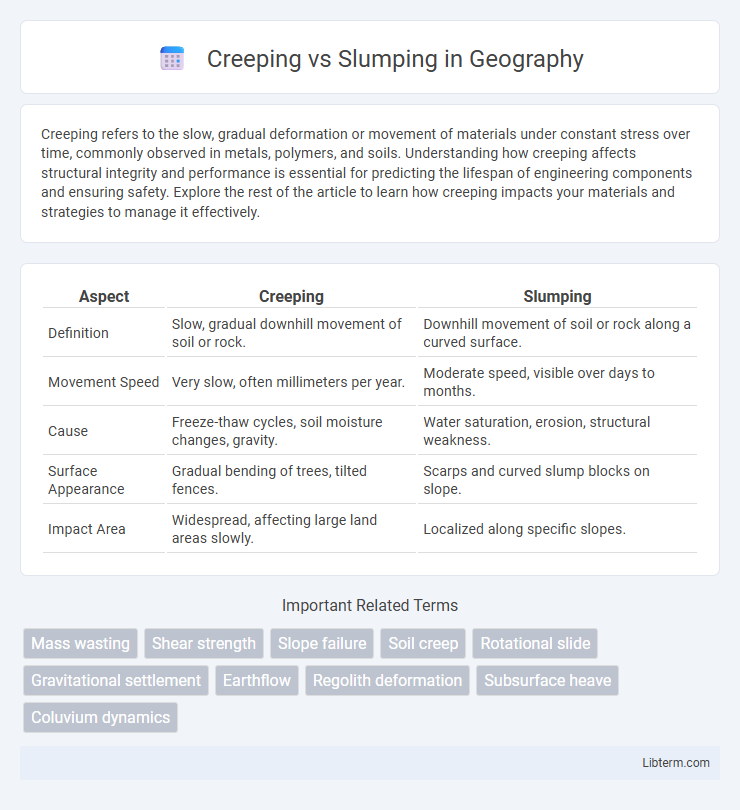Creeping refers to the slow, gradual deformation or movement of materials under constant stress over time, commonly observed in metals, polymers, and soils. Understanding how creeping affects structural integrity and performance is essential for predicting the lifespan of engineering components and ensuring safety. Explore the rest of the article to learn how creeping impacts your materials and strategies to manage it effectively.
Table of Comparison
| Aspect | Creeping | Slumping |
|---|---|---|
| Definition | Slow, gradual downhill movement of soil or rock. | Downhill movement of soil or rock along a curved surface. |
| Movement Speed | Very slow, often millimeters per year. | Moderate speed, visible over days to months. |
| Cause | Freeze-thaw cycles, soil moisture changes, gravity. | Water saturation, erosion, structural weakness. |
| Surface Appearance | Gradual bending of trees, tilted fences. | Scarps and curved slump blocks on slope. |
| Impact Area | Widespread, affecting large land areas slowly. | Localized along specific slopes. |
Introduction to Slope Movements
Slope movements encompass slow processes like creeping and rapid phenomena such as slumping, both critical to understanding soil and rock instability. Creeping describes the gradual, imperceptible downslope movement of soil or rock often driven by gravity, moisture variation, and freeze-thaw cycles. Slumping involves the sudden detachment and rotational movement of a soil or rock mass along a curved failure surface, typically triggered by rainfall, erosion, or seismic activity.
Defining Creep and Slump
Creep refers to the slow, continuous deformation of soil or rock under constant stress, often occurring over long periods due to gravity and environmental factors. Slumping involves a sudden downward and outward movement of a mass of earth or rock along a curved slip surface, typically triggered by slope instability or saturation. Both processes significantly impact slope stability and require careful geotechnical assessment for mitigation.
Key Differences Between Creep and Slumping
Creep is a slow, continuous deformation of soil or rock under sustained stress, often occurring over months or years, while slumping involves the downward rotational movement of a soil or rock mass along a curved slip surface, typically happening rapidly after saturation or disturbance. Creep deformation is gradual and usually causes minor, progressive damage such as tilting fences or bending tree trunks, whereas slumping results in visible, discrete scarps, cracks, and displaced soil blocks. The main factors influencing creep include long-term stress and moisture content, whereas slumping is strongly linked to slope instability caused by sudden increases in pore water pressure or erosion.
Causes of Creep
Creep occurs due to prolonged exposure to stress below a material's yield strength, causing time-dependent plastic deformation primarily influenced by temperature, material composition, and stress levels. High temperatures accelerate atomic diffusion and dislocation motion, key mechanisms driving creep in metals and polymers. Factors such as grain boundary sliding, vacancy diffusion, and microstructural changes significantly contribute to the initiation and progression of creep in engineering materials.
Causes of Slumping
Slumping occurs due to the saturation of soil with water, which reduces its cohesion and increases its weight, leading to a sudden downward and rotational movement along a curved slip surface. This process is often triggered by heavy rainfall, rapid snowmelt, or changes in groundwater levels that saturate the soil layers. Poor drainage, deforestation, and human activities like construction can exacerbate the instability, making slopes more prone to slumping.
Characteristics and Features of Creep
Creep is a slow, continuous, and often imperceptible deformation of soil or rock under constant stress, typically influenced by freeze-thaw cycles and wetting-drying processes. It is characterized by gradual downslope movement, surface soil sagging, and bent vegetation such as tilted tree trunks indicating persistent soil displacement. Unlike slumping, which involves rapid, blocky mass movement along a distinct failure plane, creep occurs incrementally and lacks a clear rupture surface.
Characteristics and Features of Slumping
Slumping is characterized by the rapid downward movement of soil or rock masses along a curved surface, often triggered by water saturation or erosion. Features of slumping include rotational failure, distinct slump blocks with tilted or rotated material, and the formation of scarps at the head of the slump. Unlike creeping, which is slow and gradual, slumping occurs abruptly and visibly alters the landscape.
Environmental Impacts of Creep and Slumping
Creep and slumping significantly affect landscapes by altering soil stability and vegetation patterns. Creep causes gradual soil displacement that can disrupt root systems and increase erosion, leading to habitat degradation and sedimentation in waterways. Slumping results in sudden mass movements that can destroy vegetation, alter drainage systems, and contribute to increased runoff and sediment load, impacting surrounding ecosystems and water quality.
Prevention and Control Measures
Creeping and slumping are types of mass wasting phenomena that can cause severe damage to slopes and infrastructure. Prevention and control measures include proper drainage systems to reduce water saturation, planting deep-rooted vegetation to stabilize soil, and constructing retaining walls or terracing to support slope integrity. Regular monitoring and timely geotechnical assessments help identify early signs of instability, enabling proactive maintenance and slope reinforcement.
Conclusion: Understanding Slope Stability
Creeping and slumping both indicate slope instability but differ in movement speed and mechanism, with creeping being slow, gradual deformation and slumping involving rapid mass wasting along a curved failure surface. Effective slope stability analysis requires identifying these processes to implement appropriate mitigation methods, such as drainage improvements and retaining structures. Recognizing the distinct characteristics of creeping and slumping enhances risk assessment and informs engineering solutions to prevent landslides and protect infrastructure.
Creeping Infographic

 libterm.com
libterm.com